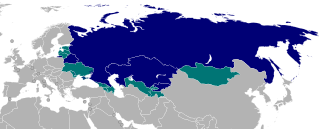Related Research Articles

Arabic is a Central Semitic language of the Afroasiatic language family spoken primarily in the Arab world. The ISO assigns language codes to 32 varieties of Arabic, including its standard form of Literary Arabic, known as Modern Standard Arabic, which is derived from Classical Arabic. This distinction exists primarily among Western linguists; Arabic speakers themselves generally do not distinguish between Modern Standard Arabic and Classical Arabic, but rather refer to both as al-ʿarabiyyatu l-fuṣḥā or simply al-fuṣḥā (اَلْفُصْحَىٰ).

French is a Romance language of the Indo-European family. Like all other Romance languages, it descended from the Vulgar Latin of the Roman Empire. French evolved from Gallo-Romance, the Latin spoken in Gaul, and more specifically in Northern Gaul. Its closest relatives are the other langues d'oïl—languages historically spoken in northern France and in southern Belgium, which French (Francien) largely supplanted. French was also influenced by native Celtic languages of Northern Roman Gaul like Gallia Belgica and by the (Germanic) Frankish language of the post-Roman Frankish invaders. Today, owing to the French colonial empire, there are numerous French-based creole languages, most notably Haitian Creole. A French-speaking person or nation may be referred to as Francophone in both English and French.

German is a West Germanic language in the Indo-European language family, mainly spoken in Western and Central Europe. It is the most spoken native language within the European Union. It is the most widely spoken and official language in Germany, Austria, Switzerland, Liechtenstein, and the Italian autonomous province of South Tyrol. It is also an official language of Luxembourg, Belgium and the Italian autonomous region of Friuli-Venezia Giulia, as well as a recognized national language in Namibia. There are also notable German-speaking communities in France (Alsace), the Czech Republic, Poland, Slovakia, Denmark, Romania and Hungary (Sopron). Overseas, sizeable communities of German-speakers are found in Brazil, South Africa (Kroondal), Namibia, among others, some communities have decidedly Austrian German or Swiss German characters.

Modern Standard Hindi, commonly referred to as Hindi, is the standardised variety of the Hindustani language written in Devanagari script. It is the official language of India alongside English and the lingua franca of North India. Hindi is considered a Sanskritised register of the Hindustani language, which itself is based primarily on the Khariboli dialect of Delhi and neighbouring areas. It is an official language in nine states and three union territories and an additional official language in three other states. Hindi is also one of the 22 scheduled languages of the Republic of India.

The Indo-European languages are a language family native to the overwhelming majority of Europe, the Iranian plateau, and the northern Indian subcontinent. Some European languages of this family—English, French, Portuguese, Russian, Dutch, and Spanish—have expanded through colonialism in the modern period and are now spoken across several continents. The Indo-European family is divided into several branches or sub-families, of which there are eight groups with languages still alive today: Albanian, Armenian, Balto-Slavic, Celtic, Germanic, Hellenic, Indo-Iranian, and Italic; another nine subdivisions are now extinct.

Japanese is the principal language of the Japonic language family spoken by the Japanese people. It has around 123 million speakers, primarily in Japan, the only country where it is the national language, and within the Japanese diaspora worldwide.

Russian is an East Slavic language belonging to the Balto-Slavic branch of the Indo-European language family. It is one of the four extant East Slavic languages, and is the native language of the Russians. It was the de facto and de jure official language of the former Soviet Union. Russian has remained an official language of the Russian Federation, Belarus, Kazakhstan, Kyrgyzstan, and Tajikistan, and is still commonly used as a lingua franca in Ukraine, Moldova, the Caucasus, Central Asia, and to a lesser extent in the Baltic states and Israel.

Spanish or Castilian (castellano) is a Romance language of the Indo-European language family that evolved from the Vulgar Latin spoken on the Iberian Peninsula of Europe. Today, it is a global language with about 500 million native speakers, mainly in the Americas and Spain, and about 600 million when including second language speakers. Spanish is the official language of 20 countries, as well as one of the six official languages of the United Nations. Spanish is the world's second-most spoken native language after Mandarin Chinese; the world's fourth-most spoken language overall after English, Mandarin Chinese, and Hindustani (Hindi-Urdu); and the world's most widely spoken Romance language. The country with the largest population of native speakers is Mexico.

Dusun is the collective name of an indigenous ethnic group to the Malaysian state of Sabah of North Borneo. Collectively, they form the largest ethnic group in Sabah. The Dusun people have been internationally recognised as indigenous to Borneo since 2004 as per the United Nations Educational, Scientific and Cultural Organization (UNESCO).

The Kadazans are an ethnic group indigenous to the state of Sabah in Malaysia. They are found mainly in Penampang on the west coast of Sabah, the surrounding locales, and various locations in the interior.

Tuaran is the capital of the Tuaran District in the West Coast Division of Sabah, Malaysia. Its population was estimated to be around 128,200 in 2019 with half the population consists of ethnic Dusuns, most of the Lotud ethnic subgroup as well of Bajau descent. The remainder is mostly of the Malaysian Chinese community, particularly from the Hakka subgroup and Malay. The town is bordered on three sides by the Tuaran River. It is located 34 kilometres (21 mi) north of the state capital Kota Kinabalu, and is strategically situated along the main highway linking Kota Kinabalu with the north of Sabah.

The Momogun Rungus are an Austronesian ethnic group indigenous to Sabah, Malaysia. They primarily live in northern Sabah especially in Kudat, Kota Marudu and Pitas districts with small minorities in the Beluran district of the east coast Sandakan Division. They have a distinct language, dress, architecture, customs and oral literature from other Dusunic sub-groups. There are around 74,000 Rungus people in the state.

Kadazandusun are the largest ethnic group in Sabah, Malaysia, an amalgamation of the closely related indigenous Kadazan and Dusun peoples. "Kadazandusun" is an umbrella term that encompasses both the Kadazan and Dusun peoples. They are also known as Mamasok Sabah, meaning "indigenous people of Sabah". Kadazandusun tradition holds that they are the descendants of Nunuk Ragang. Kadazandusun is recognised as an indigenous nation of Borneo with documented heritage by the United Nations Educational, Scientific and Cultural Organization (UNESCO) since 2004. Kadazandusuns are part of the bumiputera in Malaysia having been endowed with rights concerning land, rivers, education and maintaining their own customary laws.

English is a West Germanic language in the Indo-European language family, whose speakers, called Anglophones, originated in early medieval England on the island of Great Britain. The namesake of the language is the Angles, one of the ancient Germanic peoples that migrated to Britain. It is the most spoken language in the world, primarily due to the global influences of the former British Empire and the United States. English is the third-most spoken native language, after Standard Chinese and Spanish; it is also the most widely learned second language in the world, with more second-language speakers than native speakers.
Coastal Kadazan, also known as Dusun Tangara, is a dialect of the Central Dusun as well as a minority language primarily spoken in Sabah, Malaysia. It is the primary dialect spoken by the Kadazan people in the west coast of Sabah especially in the districts of Penampang, Papar and Membakut.
Central Dusun, also known as Bunduliwan, is an Austronesian language and one of the more widespread languages spoken by the Dusun peoples of Sabah, Malaysia.
The Dusunic languages are a group of languages spoken by the Bisaya and Dusun, and related peoples in the Malaysian province of Sabah on Borneo.
The Sabahan languages are a group of Austronesian languages centered on the Bornean province of Sabah.

Datuk Seri Panglima Md Salleh bin Md Said, commonly known as Salleh Said Keruak, is a Malaysian politician who has served as Member of the Sabah State Legislative Assembly for Usukan from February 1994 to March 2004, from May 2013 to May 2018 and again since September 2020. He served as the Minister of Communications and Multimedia in the Barisan Nasional (BN) administration under former Prime Minister Najib Razak from July 2015 to the collapse of the BN administration in May 2018, 9th Chief Minister of Sabah from December 1994 to May 1996, Speaker of the Sabah State Legislative Assembly from December 2010 to July 2015, Senator from July 2015 to July 2018 and Member of Parliament (MP) for Kota Belud from April 1995 to March 2008. He is also the son of Mohammad Said Keruak, the 4th Chief Minister of Sabah and the 7th Yang di-Pertua Negeri of Sabah.
Tun Mohd Hamdan bin Abdullah was the fourth Governor of the Malaysian state of Sabah.
References
- ↑ Lotud language at Ethnologue (25th ed., 2022)
